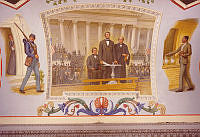Rubenstein Center Scholarship
Plantations & Politics
The Life of Henry Carter, Jr.
This article is part of the Slavery in the President’s Neighborhood initiative. Explore the Timeline
Speaking before the United States House of Representatives in 1825, congressman James K. Polk described American slavery as “a matter which required the utmost caution.”1 He viewed slavery as a fundamental part of southern culture and economics, while at the same time regretting that this “common evil” had been “entailed upon us by our ancestors.”2 While publicly conflicted over the morality of owning enslaved people, Polk managed plantations and rationalized his slave ownership, arguing that slavery was a constitutionally protected form of labor designed to enhance his economic and social standing. He utilized brutal tactics and violent overseers to expand his land and slaveholdings. Most of the people enslaved by Polk labored and lived on plantations and farms in the American South, while a few select individuals lived with the Polks and worked in a domestic setting. Henry Carter, Jr., was one such person. The Polks brought Henry, Jr. from Mississippi to work in their Tennessee homes. He was also likely the only enslaved laborer to consistently live at the Polk White House. Click here to learn more about the enslaved households of President James K. Polk.
Around 1831, Henry Carter, Jr. was born into slavery on an 880-acre plantation owned by James Polk in Yalobusha County, Mississippi.3 Henry’s parents were both enslaved by the Polks. James assumed ownership of Henry’s father, Henry Carter, Sr., to cover a $600 debt owed to him by Tennessee slave owner Archibald Carter.4 Henry, Jr.’s mother, Mariah, was originally considered part of Sarah Polk’s marriage dowry and served as an enslaved maid at the Polks’ cottage in Columbia, Tennessee. After a labor shortage arose in Mississippi, the Polks sent Mariah away from her family and forced her into field work.5 On this plantation, Mariah and Henry, Sr. conceived a child. Henry, Jr.’s survival past infancy was remarkable considering poor living conditions resulted in a 51% infant mortality rate on this property (5% higher than the national average).6

This daguerrotype of the White House was taken by John Plumbe, Jr. in early 1846 during the James K. Polk administration.
Library of CongressOn the plantation, Henry Sr. quickly became Polk’s highest earning field hand. The fact that Henry Sr. was hardworking did not imply that he was complacent with his enslavement. In October 1840, Henry, Sr. began to slow the pace of his work. This was most likely an attempt to passively resist his enslavement, a method not uncommon to those forced into bondage.7 Responding to this resistance, the plantation overseer, John J. Garner, ordered Henry, Sr. to remove his clothes and submit to a whipping. Instead of following Garner’s demand, Henry, Sr. became physical and began to fight back before fleeing the plantation with two others.8 In a letter to James Polk, Garner described the incident and the events that followed:
Henry has become so indifernt [sic] about his duty I was compeled [sic] to correct him. He resisted and fought mee [sic]. I awdered [sic] Charles to take hold of him, being the nearst [sic] but refused to dwo [sic] so. After Henry and myself [had been] combatting some time he got loose from mee [sic] and got in to the swamp. While I was pursuing him Gilbert, Charles, and Perry was running the other wey [sic]. . . I concluded that Henry would try to get his cloths [sic] while I was weying [sic] cotton at night. Got a couple of men to watch for him. While watching for him Perry was slipping up and was awdered [sic] to stand but he broke and he shot him in the legs with smawl [sic] shot so I got him, and he is at work. . . [Mariah] thinks Henry will go to his old master.9
Mariah’s belief that Henry, Sr. would run to Archibald Carter was mistaken. Henry Carter, Sr. walked nearly 110 miles to West Tennessee where he sought refuge with James Polk’s brother-in-law, Silas Caldwell. Caldwell wrote to Polk, “[Henry] says the Overseer threatened to shoot him, he says for nothing. . . Says he is afraid to go back.”10 James Polk’s response was to return Henry, Sr. to Mississippi and fire Garner for this incident. Garner was let go not because of the treatment he inflicted upon the enslaved, but for failing to stop three men from running away.
While Henry, Sr. fought his oppressors, Mariah Carter was continuously ill and used the time out of the fields to become a skilled weaver. In 1841, Mariah convinced the new overseer, Isaac Dismukes, to inform Sarah Polk that her skills on a loom had increased her value by thirty dollars.11 Mariah leveraged her valuable abilities to have her young son moved off the plantation and into domestic work.12 Later in 1841, Henry Carter, Jr. was sent away from his parents to Columbia, Tennessee, where he was put to work as a butler in the home of James K. and Sarah Polk. The reasons why a mother, like Mariah, would be so willing to part with her young child cannot be known with exact certainty, but it can be inferred that she wanted Henry, Jr. to work in the home because enslaved domestic servants generally received better treatment than field hands. Mariah was willing to give up her child to ensure that he would have a better life.

A portrait of James K. Polk by George P.A. Healy, completed in 1858.
White House Collection/White House Historical AssociationWhile Polk rebounded from two failed reelection bids for the Tennessee governorship, Henry, Jr. lived in Columbia. Unfortunately, his day-to-day experiences were not recorded by the Polks or any of their white contemporaries. As a result, we do not know how he spent his days or what he thought of Polk’s failed political aspirations. While James K. Polk turned his eye toward national politics, Henry continued his work as an enslaved person in the Polk cottage through the contentious 1844 presidential election in which Polk narrowly beat out Whig candidate Henry Clay in one of the closest races in American history.13
At the White House, President James K. Polk and First Lady Sarah Polk were personally responsible for supplying the staff, just as their predecessors before them. To save money, slave-owning presidents typically brought enslaved men and women from their plantations or estates to act as butlers, maids, cooks, or valets. James Polk also relied on the enslaved to fill these roles. Elias Polk was one of the individuals enslaved by the Polks at the White House, before Elias’s post-emancipation oratorical career catapulted him to controversial notoriety.14 Elias resided at the Executive Mansion briefly before he was sent back to Tennessee and forcibly “rented out” by President Polk to his former law partner, James H. Thomas.15 As other enslaved individuals came and went, Henry Carter, Jr. remained at the White House for the majority of the Polk presidency. Most likely he attained a high position in the household staff, perhaps as a butler or valet to the president.
Since Henry Carter, Jr. could neither read nor write he left behind no record of his thoughts or actions. Like many other enslaved individuals, Henry Carter, Jr.’s life was overwhelmingly dictated by those in white society and not recorded in great detail. Providing context for the life of someone held in slavery, Lewis Clarke, a man who had been enslaved in Kentucky, once said of working in his masters home, “We were constantly exposed to the whims and passions of every member of the family; from the least to the greatest their anger was wreaked upon us…We were always required to sit up until all the family had retired; then we must be up at early dawn in summer, and before day in winter.”16
Henry never wrote a “tell all” memoir nor did he divulge much information regarding his enslavement to newspapers during his later life, so we do not know how his experience compared to that of Lewis Clarke. Due to the lack of sources detailing this critical period, the exact nature of his relationship to James or Sarah Polk is unknown. The Polks may have thought of Henry, Jr. as “property,” but he did think and feel, he was human. Piecing together his life is difficult, but some details are certain. Polk’s papers provide insight into Henry, Jr.’s whereabouts and actions.

A photograph of Polk Place from the late 1890s.
Courtesy of the Tennessee State Library and ArchivesOne of the few existing primary sources regarding Henry, Jr.’s time in the White House comes in the form of a letter written by President Polk in July 1847. Writing to Sarah, who was away visiting family in Tennessee, Polk wrote:
I wrote to you on yesterday, and after closing my day’s labour [sic], write again to night [sic], not that I have anything of interest to communicate…I miss you in the White House. When I went down to breakfast this morning none of the family appeared. They are all fine-sleepers… I asked Henry if he had notified them. He answered “Yes Sir, but things was a heap straighter when Miss Sarah was here.17
If these are the actual words of Henry Carter, Jr. or just an amusing sycophantic tale reported from a lonely husband is a matter of conjecture. More than anything else, this letter offers a small window into the nature of Henry’s White House years. He was expected to rise early enough to wake the home’s white occupants and begin his daily tasks as an enslaved person.
Most likely Henry, Jr. would have held a wide array of duties at the Polk White House. When coming into the home, First Lady Sarah Polk made cuts to the staff to save money. She fired the baker, chef, a steward who had worked at the Executive Mansion for over a decade, and several other employees. To fill the void, the enslaved Paul Jennings was hired out to the Polks by Dolley Madison and a new steward, Henry Bowman, was brought in at a cheaper rate than his predecessor.18 At this time with so few working in the White House, it would have been “all hands on deck” to accommodate the many guests visiting the president’s home.
Henry, Jr. could have been serving the lavish dinners held by the Polks. After attending one of these meals in December 1845, Elizabeth L. C. Dixon, wife of a Connecticut congressman, recorded in her diary, “The table & dinner was as handsome as any I ever saw. . . The servants wore dark blue coats, white vests, cravats, & gloves. . . ‘Sit I guess we did sit,’ four mortal hours. . . I judge 150 courses.”19 He also could have served as a doorman and been the one to greet and direct guests. In 1849, the Rev. Dr. Dixon, a Methodist minister, came to the White House and met an unnamed “servant of the President” who may have been Henry, Jr. He reported his visit to newspapers:
We hastened to the President’s House to see if we could gain access, and be favored with an interview with the first magistrate of the Republic. On our arrival we met a black man, the only servant of the President we saw; and, on asking if it would be possible to obtain an interview, he said he saw no difficulty in the case, but would inquire. He went. . . and soon returned with a message that the President would be very happy to see us.20
James Polk left the presidency in 1849 and on March 5 recorded his thoughts in his diary as he departed the nation’s capital: “We found the Boat much crowded with members of Congress and others going South. I was much fatigued, but had but little rest… I take with me Henry Bowman, my late steward, to pay bills, take care of my baggage, &C. I take with me also my servant (Henry)…”21 Once back in Tennessee, the Polks settled into a large Greek Revival style mansion near downtown Nashville they called “Polk Place.”

This letter includes floor plans for Polk Place and the Slave Quarters behind it. See J.M. Hughes, letter to Vernon K. Stevenson for James K. Polk, October 18, 1847.
Courtesy of the Tennessee State Library and ArchivesThe home was finished with elegant Empire-style sofas and gentleman’s chairs adorned with beautifully crafted rosewood frames, all of which were covered in red velvet and silk upholstery. The furnishings sat in large rooms covered in geometric patterned woven carpet which stretched throughout the house, and matching nicely to the gray wallpaper which resembled what Sarah had installed in the White House.22 Contrasting sharply with this symbol of southern aristocracy, on the back of the property stood two 18` x 33` x 10` framed structures which were divided equally into rooms and occupied by the enslaved—Elias, Matilda (an elderly cook whom the Polks moved from a plantation in West Tennessee), Mariah, and Henry Carter, Jr.23
James K. Polk died, a victim of a cholera outbreak, on June 15, 1849. He remains the president with the shortest retirement, just over three months.24 In his will, James left all the enslaved people he owned to Sarah with a provision that they gain freedom upon her death.25 Neither James nor Sarah would emancipate these individuals, however. Toward the end of the Civil War, Congress passed the 13th Amendment. Slavery was officially abolished once enough states ratified the amendment in December 1865.
Following his emancipation, Henry, Jr., now around age thirty-eight, disappeared from surviving sources, but some documentation suggests he may have participated in discussions about emigration. In late September 1869, prominent African-American citizens in Davidson County, Tennessee (Nashville’s county) met to discuss black emigration. Threats of violence from former slave owners, Confederates, and the newly formed Ku Klux Klan concerned enough African Americans to consider relocating from the South to a western territory or state where there might be fewer individuals committed to reestablishing a white supremacist racial hierarchy.26

A closeup of the floor plan for the Slave Quarters of Polk Place. See J.M. Hughes, letter to Vernon K. Stevenson for James K. Polk, October 18, 1847.
Courtesy of the Tennessee State Library and ArchivesA man named Henry Carter attended this meeting. It was reported that, “A number of the colored people…held a meeting at the courthouse for the purpose of discussing the propriety of moving West and settling in Colorado, Kansas, or some other portion of that country… Henry Carter at once sprang to his feet and asked the chairman if they were ready for business.”27
This Henry Carter argued that if emigration were to take place perhaps individuals should move to Mississippi. African Americans outnumbered the white citizenry in Mississippi and Hiram Revels was elected as the first person of African descent to represent a state in Congress.28 This suggestion was quickly shot down as presiding chairman Randal Brown pointed out, “Native Negros were leaving Mississippi which they viewed as a medieval place filled with racists, their terrorism, and the worst kind of human brutality.”29
While there is no way to know with 100% certainty that this individual was the same Henry Carter enslaved by President James K. Polk, the circumstantial evidence suggests a connection. This person was in the right place, at the right time, with the right name, and argued for emigration to the state where the Henry Carter, Jr. had family roots. Furthermore, the meeting records mention Elias Polk as one of the attendees. This places an individual with a strong connection to Henry Carter, Jr. in the very same scene. Based on this information, it is likely that this Henry Carter was the very same man who was held in slavery at the White House from 1845-1849.
The lack of primary source material, family separation, and individual illiteracy make it unlikely that historians or the public will ever know the full life of Henry Carter, Jr., or the lives of millions of other enslaved people held in bondage. Though, in the case of Henry Carter, Jr., contextual evidence does reveal an individual whose experiences remain valuable to researchers today as a witness to both plantations and politics.
A native of Maury County, Tennessee, Zacharie W. Kinslow holds a masters degree from Austin Peay State University. For five years he worked at the President James K. Polk Home & Museum in Columbia, Tennessee as a docent and educator. Zacharie’s research interests primarily involve slavery and the America presidency as well as Jacksonian America.





